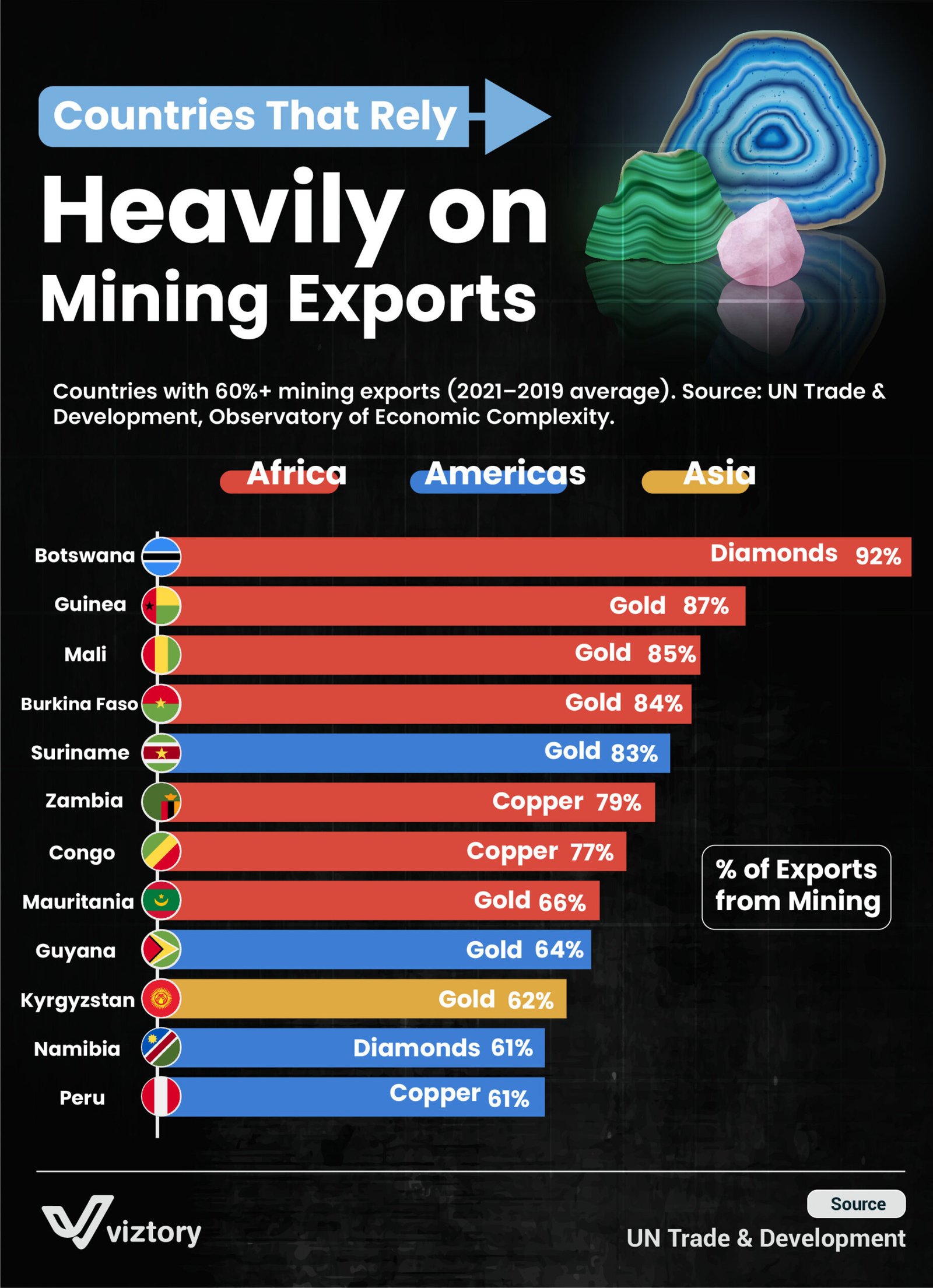Countries That Rely Heavily on Mining Exports
-
Jan, Sun, 2025
Mining exports play a critical role in the economic frameworks of many nations, serving as a lifeline for foreign currency generation, GDP growth, and economic development. According to data from the UN Trade & Development and the Observatory of Economic Complexity, numerous countries exhibit a significant dependency on mining exports, with mining products accounting for over 60% of their total exports. This reliance reflects not only the natural resource wealth of these countries but also the structural challenges that arise from such economic concentration.
The Distribution of Mining Dependence
The infographic highlights countries from three major regions—Africa, the Americas, and Asia—where mining exports constitute a large portion of the economy. Here’s an analysis of the data:
Africa dominates the list with countries like:
- Botswana: The world’s largest diamond producer, with diamonds contributing 92% of its exports. Botswana’s economic success story is built on its ability to channel diamond revenues into infrastructure and human development.
- Guinea and Mali: Both heavily reliant on gold, at 87% and 85%, respectively. Guinea’s untapped reserves and recent foreign investment indicate growth potential, while Mali faces challenges tied to political instability.
- Burkina Faso and Mauritania: Also gold-dependent, reflecting the broader West African gold belt’s prominence in global markets.
- Zambia and Congo: Focused on copper, contributing 79% and 77% of their exports, respectively. Copper is essential for global electronics and green energy infrastructure, giving these nations a strategic edge but also exposing them to price volatility.
The Americas feature prominently with:
- Suriname: With gold making up 83% of its exports, the country’s economy is tied to fluctuating global gold prices.
- Guyana and Peru: Their heavy dependence on gold and copper exports (64% and 61%, respectively) reflects their vast mineral wealth. However, these economies remain vulnerable to shifts in demand, particularly from key markets like China.
Asia’s notable representative:
- Kyrgyzstan: Gold constitutes 62% of its exports, making it a significant economic driver in a landlocked and resource-dependent country.
Namibia: Standing out as another diamond-dependent nation (61%), its economy mirrors Botswana’s but with a more diversified export portfolio.
The Economic Implications of Resource Dependence
Resource dependence brings both opportunities and risks. For resource-rich countries, mining serves as a critical source of income and employment. The foreign exchange generated helps to fund imports, stabilize currencies, and drive economic growth. Botswana, for example, has successfully leveraged its diamond wealth to become one of Africa’s most stable and prosperous economies.
However, excessive reliance on mining exposes economies to external shocks. Price volatility, geopolitical tensions, and shifting global demand can lead to significant economic instability. For example:
- A drop in gold or copper prices can severely impact the revenues of Mali or Zambia.
- Overdependence on a single resource (like diamonds in Botswana) increases vulnerability to market disruptions.
- Environmental concerns and rising global focus on sustainable practices may challenge the mining industry, demanding reforms and diversification.
Diversification: A Strategic Imperative
To mitigate the risks associated with resource dependence, these nations must invest in economic diversification. Strategies include:
- Developing downstream industries to add value to raw materials.
- Investing in education, healthcare, and infrastructure to build human capital.
- Encouraging investments in renewable energy, agriculture, and manufacturing.
Botswana’s model of reinvesting diamond revenues into infrastructure and public services offers a blueprint for others. Similarly, countries like Zambia and Congo can leverage their copper industries to drive innovation in green energy technologies.
Conclusion
The infographic underscores the critical role of mining exports in shaping the economies of resource-rich nations. While these countries enjoy the benefits of their natural wealth, their heavy reliance on mining presents challenges tied to global market dynamics. Sustainable economic growth requires strategic investments in diversification, innovation, and governance to reduce vulnerability and ensure long-term prosperity.

